USSEC Arranges U.S. Senate Appropriations Subcommittee on Agriculture, Rural Development, Food and Drug Administration, and Related Agencies’ Visit to Egypt’s Aquaculture Sector
- Category:
- Aquaculture
- General News

USSEC worked closely with the Foreign Agricultural Service (FAS) to arrange a visit to a fish farm in Egypt for members of the U.S. Senate Appropriations Subcommittee on Agriculture, Rural Development, Food and Drug Administration, and Related Agencies on February 22.

The visit included the following members from the Senate Appropriations Subcommittee on Agriculture, Rural Development, Food and Drug Administration and Related Agencies: Rachel Santos, professional staff; Carlisle Clarke, majority clerk; Patrick Carroll, professional staff; and Jessica Schulken, minority clerk.
The visit also included members of the U.S. Department of Agriculture (USDA) / FAS: Chris Church, Director, Legislative Affairs; Ronald Verdonk, Minister-Counselor; and Dr. Ahmed Wally, Agricultural Specialist.
Essam el Barabary, a prominent member of the Egyptian aquaculture industry, hosted the visitors at his farm in Burg el Arab outside of Alexandria.
Hussain Mansour, chief executive of Aller Aqua Egypt, an Egyptian-Danish partnership company, also attended the tour. Aller Aqua is among the top aqua feed producers in Egypt with a production capacity up to 150,000 metric tons of extruded feed, making the company the largest feed producer in Egypt.
During the visit, Mr. Essam explained the production strategy for the farm and the advantage of having good water quality. He explained that water quality at the farm has enabled him to produce a variety of fish species including tilapia, mullet, sea bass, and European eel. Mr. Essam said that the feed for the farm is supplied predominantly from Aller Aqua.

Mr. Hussain explained that Egypt ranks eighth in terms of world aquaculture production, second in the production of tilapia, and first in mullet production. He also stressed the importance of using high quality raw material in feed production and that his preference to use U.S. soybean meal is for its digestibility and consistent quality. He stated that the quality attributes of U.S. soybean meal are clearly visible upon physical evaluation of the product.
During the discussion, Mr. Hussain pointed out that digestibility of U.S. soybean meal, measured by protein solubility (KOH) was clearly demonstrated during a feed trial that was conducted during 2013, which was sponsored by USSEC and implemented at WorldFish. At that time, Aller Aqua produced the feed according to the parameters and formulation provided by USSEC, primarily the use of U.S soybean meal in the diet. Mr. Hussain went on to explain that the growth rate achieved during the trial is due to the highly digestible protein content of U.S. soybeans.
USSEC Country Representative – Egypt Salah Taher, who organized the visit together with USDA/FAS, explained to the committee members that building a preference for U.S. Soy in the Egyptian aquaculture industry is a continuous effort that the USSEC team has been promoting through close cooperation with the aqua industry. Seminars, feed trials, and one-on-one technical visits are among the tools used by USSEC to demonstrate the advantage of using U.S. Soy.

Mr. Taher went on to explain the scale of the Egyptian aquaculture, an industry that produces 1.2 million metric tons (MMT) of fish annually and is the primary source of protein for 90 million Egyptians. Per capita consumption of fish is currently 21 kilograms (kg) higher than the per capita world average, which is approximately 19 kg.
Mr. Essam also hosted a luncheon, which was served in a traditional Egyptian tent. During lunch, Mr. Essam and his colleagues presented a number of general topics, including the importance of developing a cold chain and cold storage to overcome the price fluctuation that results from seasonality of supply.

